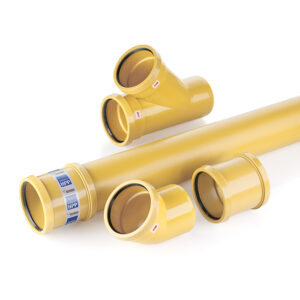Sewer system infrastructure construction poses complex challenges and concerns for construction professionals. Specifically, the choice of pipe and manhole chamber materials can have far-reaching consequences if improperly chosen. Taking this into account, Franz Huelle, Head of Technical at REHAU Building Solutions, discusses how using polypropylene in sewage systems piping can result in stronger, safer infrastructure.
The UK sewer network is vast, with over 640,000km of pipe used by approximately 90 per cent of the country’s population. Over 16 billion litres of wastewater passes through this network daily, with 9,000 sewage treatment works responsible for processing effluent.
The most common materials constituting this network are clay, concrete and polymer pipes, and each has strengths and weaknesses. The daily stress on these pipes means project stakeholders and construction professionals must understand which substances are best-suited to sewage applications.
The harshness of the sewage environment has clear implications for the UK’s national infrastructure. Indeed, a sewer conditions report from the German Association for Water, Wastewater and Waste (DWA) outlines a situation likely mirrored in other countries’ sewerage infrastructure.
It highlights common sewer pipe problems including cracks, deformation, leaks and obstacles like roots and deposits, and how pipes could be compromised by moved or damaged seals and fittings, bursts, poor repair, or impaired surfaces and lateral connections. The dynamic load and stress placed on sewer pipes by increased road traffic, and especially loaded HGVs, also threatens sewerage infrastructure.
Such issues make performance-reducing concerns like water infiltration, sediment build-up, soil ingress, pipe deformation, stagnant water and foreign obstacles more likely, with pipe collapse and system failure possible. The DWA report also suggested that 20 per cent of German sewage pipes very badly damaged – a scenario also possible in Britain.
Impaired manhole chambers
There are similar concerns around sewer manhole chambers. Approximately 90 per cent of these chambers are made from concrete, which will deteriorate under everyday strain and being used as a point-of-access by infrastructure maintenance personnel. Further DWA reports in 2015 highlighted how ladder and manhole cover or frame concerns, including cracks, corrosion, collapse, water infiltration, soil ingress and ladder damage, represented almost 50 per cent of overall chamber issues.
Consequently, chambers can become unsafe to enter, drive over or even hold water satisfactorily. Specifying the right sewer pipe materials is therefore vital, and knowing their use and limitations can reduce the likelihood of such systems falling into disrepair.

Practical polypropylene
One such option that is becoming a popular choice for new sewer works is a polymer called polypropylene, or PP. PP’s durability, excellent chemical resistance of pH 1-13 and high temperature resistance of up to 95°C in the short term makes it well-suited to harsh sewer environments. The well-engineered pipe seal systems from suppliers like REHAU also eliminate common issues around root ingress.
Furthermore, PP uses virgin grade materials without fillers, as opposed to competitor pipes that use up to 40 per cent in mineral additives. This greater filler quantity results in stiffer pipes and significantly reduced dynamic load capacity – a common issue for concrete piping. Such rigidity can have a dramatic impact, with virgin grade PP pipes enjoying up to 250 times the strength of equivalent, filler-using materials.
The added flexibility allows the weight and impact of heavy loads to be transferred into ground around the pipe, ensuring greater long-term strength and reliability. PP also has 40 times the impact resistance of clay, the most commonly used sewer pipe material, and virtually rules out damage like cracks and fractures occurring on-site.
REHAU PP pipes are lighter than concrete and clay alternatives, so more meterage can be laid hourly by fewer personnel, lower contractor costs. They can also be pressure-jetted for easier maintenance – for example, the 250mm pipe is verified by the UK’s Water Research Centre (WRc) up to 280 bar, and feature an intuitive Safety-Lock jointing system leak-proof up to 5 bar short-term internal pressure to ensure reliable, watertight fits.
Manhole chamber alternatives
PP manhole chambers also have a similar Safety-Lock sealing system to keep chambers watertight. The material’s strength allows manhole chamber cones to withstand 10-tonne wheel loads – twice that of an HGV – as its surrounding polymer or concrete ring can deflect the weight. Even if the ring were impaired, PP cones can still handle direct contact with 10-tonne weights.
REHAU-supplied chambers also feature a slip-proof, corrosion-resistant ladder design for continued safe access, and the material enjoys an externally verified 100-year service life from independent inspection body TÜV Rheinland. Additionally, the material meets British Standard EN 13598-2, which governs plastic piping and ducting systems, meaning dangerous defects affecting long-term use and safety are extremely unlikely.
Because PP manhole chambers are also up to 95 per cent lighter than concrete versions, they can be easily aligned and installed without machinery. As such, site safety can be improved and construction costs lowered, as less plant machinery is required.
In conclusion, though sewage systems can be made of a number of different materials, only PP polymers can guarantee a long service life in an extremely demanding environment, while remaining easy and practical to install. A high-performing, long-lasting material, its comparatively low weight and innovative design optimises installation site processes while improved personnel safety.
For more information on REHAU’s polypropylene sewer pipe and chamber solutions, please visit: www.rehau.uk/awadukt.




